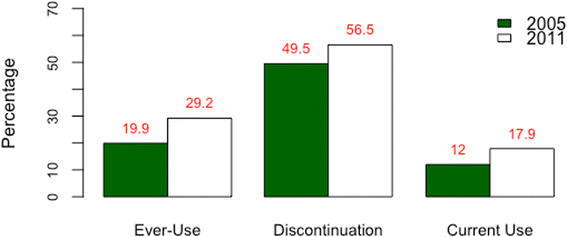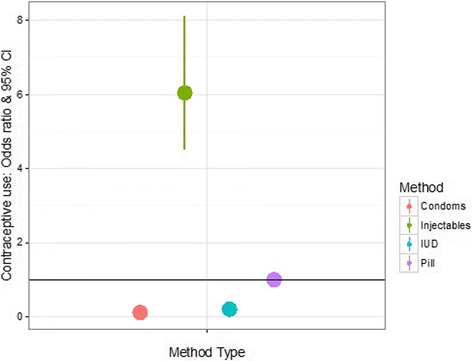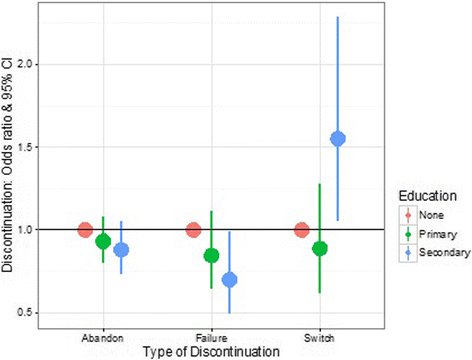Side effects and the need for secrecy: characterising discontinuation of modern contraception and its causes in Ethiopia using mixed methods
- PMID: 29201429
- PMCID: PMC5683325
- DOI: 10.1186/s40834-017-0052-7
Side effects and the need for secrecy: characterising discontinuation of modern contraception and its causes in Ethiopia using mixed methods
Abstract
Background: Contraceptive discontinuation is a major barrier to reducing global unmet needs for family planning, but the reasons why women discontinue contraception are poorly understood. Here we use data from Ethiopia to investigate (i) the magnitude of contraceptive discontinuation in 2005-2011, (ii) how the risk of discontinuation varies with method type and education level and (iii) the barriers to continuation. Our main hypothesis is that contraceptive discontinuation is driven by the experience of physiological side-effects associated with the use of hormonal contraception, rather than a lack of formal education.
Methods: We used a mixed methods explanatory sequential design to explain the quantitative results in more details through the qualitative data. First, we analysed quantitative data from the 2011 Ethiopian Demographic and Health Survey to study patterns of contraceptive discontinuation and method choice using multilevel multiprocess models. Second, we conducted semi-structured interviews and focus group discussions in the 3 most populated regions of Ethiopia with individuals of reproductive age and health professionals.
Results: The analysis of EDHS data shows that the rate of discontinuation has not reduced in the period 2005-2011 and remains high. Discontinuation mainly takes the form of abandonment, and is a function of method type, age and wealth but not of educational level. Interviews with women and health professionals reveal that the experience of debilitating physiological side effects, the need for secrecy and poverty are important barriers to continuation.
Conclusions: Our findings together suggest that physiological and social side-effects of contraceptive use, not a lack of formal education, are the root causes of contraceptive abandonment in Ethiopia.
Keywords: Contraceptive discontinuation; Education; Ethiopia; Family planning; Mixed methods; Multilevel multiprocess modelling; Reproductive ecology; Semi-structured interviews; Side-effects; Unmet needs.
Conflict of interest statement
Ethics approval and consent to participate
For the qualitative study, ethic approval has been granted by the Institute of Development and Policy Research from the Ethiopian University of Addis Ababa. The ethical procedure associated with DHS data collection can be found on the DHS website
Consent for publication
Oral consent was obtained for publishing anonymized quotes, as part of the general ethical procedure.
Competing interests
The authors declare that they have no competing interests.
Publisher’s Note
Springer Nature remains neutral with regard to jurisdictional claims in published maps and institutional affiliations.
Figures




Similar articles
-
A qualitative exploration of contraceptive use and discontinuation among women with an unmet need for modern contraception in Kenya.Reprod Health. 2021 Feb 9;18(1):33. doi: 10.1186/s12978-021-01094-y. Reprod Health. 2021. PMID: 33563304 Free PMC article.
-
Magnitude and factors for method discontinuation and switching among long acting reversible contraceptive users in health facilities of Southern Ethiopia.Reprod Health. 2022 Feb 19;19(1):47. doi: 10.1186/s12978-022-01357-2. Reprod Health. 2022. PMID: 35183214 Free PMC article.
-
Spatial variations and multilevel mixed effect analysis on determinants factors of modern contraceptive utilization among reproductive age women in Ethiopia; proven by Ethiopian mini demographic health survey 2019.BMC Womens Health. 2023 Feb 22;23(1):77. doi: 10.1186/s12905-022-02030-3. BMC Womens Health. 2023. PMID: 36814235 Free PMC article.
-
Strategies to improve adherence and continuation of shorter-term hormonal methods of contraception.Cochrane Database Syst Rev. 2019 Apr 23;4(4):CD004317. doi: 10.1002/14651858.CD004317.pub5. Cochrane Database Syst Rev. 2019. PMID: 31013349 Free PMC article.
-
Canadian Contraception Consensus (Part 1 of 4).J Obstet Gynaecol Can. 2015 Oct;37(10):936-42. doi: 10.1016/s1701-2163(16)30033-0. J Obstet Gynaecol Can. 2015. PMID: 26606712 English, French.
Cited by
-
A qualitative exploration of contraceptive use and discontinuation among women with an unmet need for modern contraception in Kenya.Reprod Health. 2021 Feb 9;18(1):33. doi: 10.1186/s12978-021-01094-y. Reprod Health. 2021. PMID: 33563304 Free PMC article.
-
Contributions of side effects to contraceptive discontinuation and method switch among Kenyan women: a prospective cohort study.BJOG. 2022 May;129(6):926-937. doi: 10.1111/1471-0528.17032. Epub 2022 Jan 18. BJOG. 2022. PMID: 34839583 Free PMC article.
-
Understanding 'missed appointments' for pills and injectables: a mixed methods study in Senegal.BMJ Glob Health. 2018 Dec 30;3(6):e000975. doi: 10.1136/bmjgh-2018-000975. eCollection 2018. BMJ Glob Health. 2018. PMID: 30687521 Free PMC article.
-
Acceptability and utilization of family planning benefits cards by youth in slums in Kampala, Uganda.Contracept Reprod Med. 2019 Aug 5;4:10. doi: 10.1186/s40834-019-0092-2. eCollection 2019. Contracept Reprod Med. 2019. PMID: 31396395 Free PMC article.
-
Wealthy, urban, educated. Who is represented in population surveys of women's menstrual hygiene management?Reprod Health Matters. 2018 Dec;26(52):1484220. doi: 10.1080/09688080.2018.1484220. Reprod Health Matters. 2018. PMID: 30027825 Free PMC article.
References
-
- Singh S, Darroch JE. Adding it up: costs and benefits of contraceptive services estimates for 2012. 2012.
-
- Jacobstein R, Curtis C, Spieler J, Radloff S. Meeting the need for modern contraception: effective solutions to a pressing global challenge. Int J Gynaecol Obstet. 2013;121(Suppl 1):S9–15. doi:10.1016/j.ijgo.2013.02.005. Epub 2013 Mar 6. - PubMed
LinkOut - more resources
Full Text Sources
Other Literature Sources

